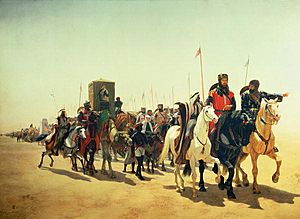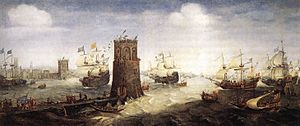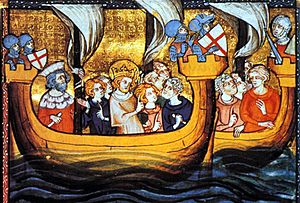Crusades facts for kids
The Crusades were a series of religious wars. They were fought mainly between Christians from Europe and Muslims over control of the Holy Land. This land is very important to three major religions: Islam, Judaism, and Christianity. It includes places like Jerusalem, Nazareth, and Bethlehem. These places are now part of Israel and Palestine.
Traditionally, the main Crusades happened between 1095 and 1291. Before the Crusades, important religious sites in the Holy Land came under Muslim control during the time of the Caliphate of Omar (634-44).
Many Crusades
There were many different Crusades. The biggest and most important ones took place from the 11th century (1000s) to the 13th century (1200s). During this time, there were nine large Crusades, numbered 1 through 9. There were also many smaller Crusades. Some of these smaller Crusades even happened within Europe, for example, in Germany, Austria, and Scandinavia. These smaller Crusades continued until the 16th century, around the time of the Renaissance (a period of new ideas) and the Reformation (a big change in Christianity).
The word "Crusade" comes from "Cross" and means a Christian holy war. Muslims also have a similar idea called "Jihad", which refers to a holy struggle. People on all sides—Christians, Muslims, and Jews—had very strong religious beliefs. They also had political reasons for fighting. These strong beliefs made it hard for people to understand each other during times of conflict. The Crusades and Jihads caused a lot of loss of life and property for everyone involved.
First Crusade (1095-1099)
In 1095, Alexius I, a ruler of the Byzantine Empire, asked for help to defend his empire from the Seljuk Turks. Pope Urban II then asked all Christians to join a war against the Turks. The Pope told Christians that fighting in this war would make up for their sins. He also said that if they died on a Crusade, they would go straight to heaven. The Christian soldiers were called "crusaders". Their armies marched towards Jerusalem, attacking several cities along the way. In 1099, they won the battle for Jerusalem. After the First Crusade, several small Crusader states were created, including the Kingdom of Jerusalem.
Second Crusade (1147-1149)
After some years of peace, Bernard of Clairvaux called for a new Crusade. This happened after the town of Edessa was attacked by the Turks. French and German armies marched to the Holy Land in 1147, but they were defeated. On their way, the Crusaders helped the Portuguese capture Lisbon from the Moors.
Third Crusade (1189-1192)
In 1187, Saladin recaptured Jerusalem. Pope Gregory VIII called for a new Crusade. This one was led by several kings from Europe: Philip II of France, Richard I of England (also known as Richard the Lionheart), and Frederick I, Holy Roman Emperor. Frederick drowned in Cilicia in 1190. The Crusaders managed to set up the Kingdom of Jerusalem again in a city called Acre. Richard defeated Saladin in battles at Arsuf and Jaffa. However, he didn't have enough soldiers to try and recapture Jerusalem. Richard and Saladin then made a truce that allowed Christians to travel safely through Jerusalem. Richard left in 1192. On his way home, his ship was wrecked, and he ended up in Austria. There, his enemy Duke Leopold captured him, and Richard had to be ransomed (paid for his freedom).
Fourth Crusade (1202-1204)
The Fourth Crusade was started by Pope Innocent III in 1202. The original idea was to attack the Holy Land through Egypt. However, the Venetians changed the plan. They went to the Christian city of Constantinople instead. There, they tried to put a Byzantine exile (someone forced to leave their home country) on the throne. After many misunderstandings and outbreaks of violence, the city was sacked (attacked and robbed) in 1204.
Albigensian Crusade (1209-1229)
The Albigensian Crusade began in 1209. Its goal was to get rid of the Cathars, a Christian group in southern France who were seen as heretics by the Catholic Church.
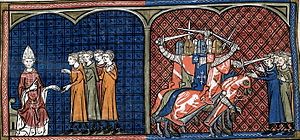
Children's Crusade (1212)
The Children's Crusade happened in 1212. It was a time when many children in France and Germany were filled with religious excitement. A boy, from either France or Germany, said that Jesus had visited him. He claimed Jesus told him to peacefully convert Muslims to Christianity. Following this vision, many children formed groups and marched to Italy. There, they were put onto ships. Sadly, these ships either capsized in a storm or sailed to Morocco. Most of the children either starved to death or were sold into slavery.
Fifth Crusade (1217-1221)
From 1213, Pope Gregory IX encouraged Frederick II to lead the Fifth Crusade. The Church tried another Crusade to attack the Holy Land. A crusading force from Hungary, Austria, and Bavaria captured Damietta, a city in Egypt, in 1219. However, the crusaders had to surrender after losing a battle for Cairo.
Sixth Crusade (1228-1229)
In 1228, Emperor Frederick II sailed from Brindisi to Syria. He did this even after the Pope had excommunicated him (kicked him out of the Church). Frederick had success by talking to the Turks. As a result, Jerusalem, Nazareth, and Bethlehem were given to the Crusaders for ten years without any fighting. This was the first major Crusade not started by the Pope, a trend that continued for the rest of the century. This Crusade only lasted for a year, from 1228-1229.
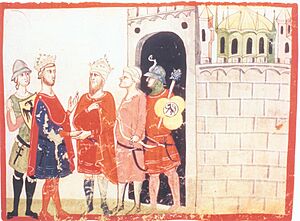
Seventh Crusade (1248-1254)
The Templars had a disagreement with Egypt in 1243. In 1244, Egypt attacked Jerusalem. Louis IX of France started a Crusade against Egypt from 1248 to 1254. It was a failure, and Louis spent much of the Crusade living in Acre. During this Crusade, the first Shepherds' Crusade happened in 1251.
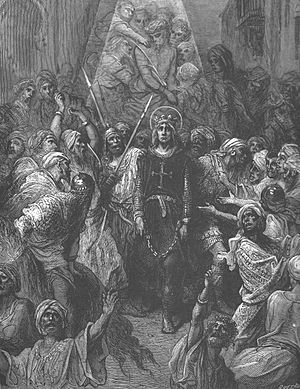
Eighth Crusade (1270)
The Eighth Crusade was organized by Louis IX of France in 1270. Its goal was to help the Crusader states in Syria. However, the Crusade only reached Tunis, where Louis died a month later.
Ninth Crusade (1271-1272)
Before he became king, Edward I of England started a Crusade in 1271. He ended it the following year after a truce was made.
The end of the Crusades
Over time, people went on Crusades for different reasons. The main Crusades ended about two centuries after they began. They had mixed results. The Crusades ended with the Fall of Acre in 1291.

Images for kids
-
Nūr-ad-Din's victory at the Battle of Inab, 1149. Illustration from the Passages d'outremer, c. 1490.
-
The defeat of the Crusaders at Gaza, depicted in the Chronica majora of Matthew Paris, 13th century.
-
Map of the branches of the Teutonic Order in Europe around 1300. Shaded area is sovereign territory.
-
William of Tyre writing his history, from a 13th-century Old French translation, Bibliothèque Nationale, Paris, MS 2631, f.1r
See also
 In Spanish: Cruzadas para niños
In Spanish: Cruzadas para niños


